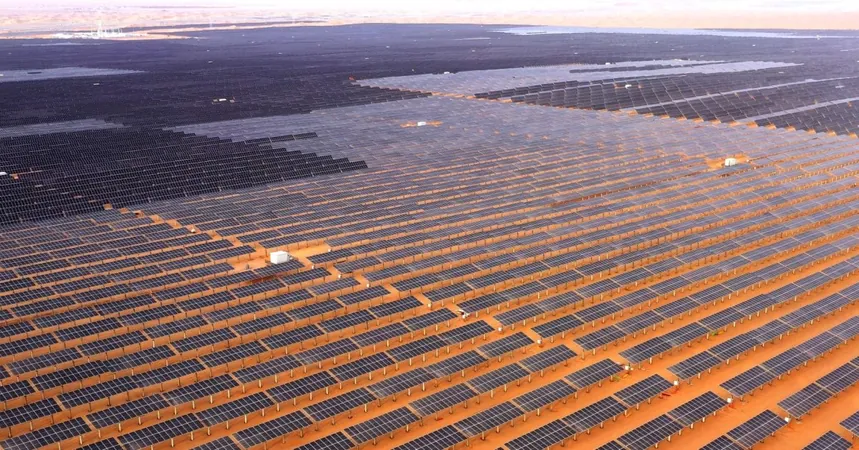
China Dominates Global Energy Investment, Surpassing US and EU Combined
2025-06-05
Author: Jessica Wong
Record Energy Investment Forecast for 2025
The latest International Energy Agency (IEA) report reveals that global energy investments are projected to soar to an unprecedented $3.3 trillion by 2025. This surge comes as nations grapple with economic uncertainties and rising geopolitical tensions.
Clean Technology Takes the Lead
A staggering $2.2 trillion of the total investment will be funneled into clean technologies, such as renewables, nuclear energy, smart grids, battery storage, and low-emission fuels—twice the amount allocated for fossil fuels. IEA Executive Director Fatih Birol emphasized that energy security has become a crucial motivator for this substantial financial growth.
China Emerges as a Powerhouse in Energy Spending
China has solidified its position as the world's leading energy investor, spending close to what the US and EU invest combined. This dramatic shift began in 2015 when China narrowly surpassed the US, and it has now expanded its lead, especially in clean energy investments. In just a decade, China has increased its stake in global clean energy spending from 25% to nearly 33%, primarily due to massive investments in solar, wind, hydro, nuclear energy, electric vehicles, and batteries.
Solar and Battery Storage: The Rising Stars
Solar energy continues to shine, with investments in rooftop and utility-scale solar projected to reach $450 billion this year, making it the most funded energy technology worldwide. Battery storage is also on the rise, with expectations of hitting $65 billion by 2025, while nuclear energy funding has surged by 50% over five years to approximately $75 billion.
Shifting Energy Mix and Infrastructure Challenges
The global energy landscape is rapidly evolving. While fossil fuel investments once outpaced electricity spending by 30% in 2015, this year, electricity investments—including generation, grids, and storage—are projected to surpass fossil fuels by 50%. However, not all indicators are positive. Grid investments currently stand at $400 billion annually but are lagging behind the pace of new energy generation, raising alarms about electricity security. The IEA warns of the urgent need for grid improvements, hampered by permitting delays and supply chain issues.
Controversial Coal Investments Persist
Despite the emphasis on clean energy, both China and India are still heavily investing in coal. China is set to start nearly 100 gigawatts of new coal-fired power plants in 2024, marking a worrying trend with the highest approvals for new coal projects since 2015.
Oil and LNG Market Trends
Investment in oil is anticipated to decline by 6% this year—the first dip since the COVID-related crash in 2020—largely due to reduced spending on US tight oil production. Conversely, liquefied natural gas (LNG) investments are surging, especially in the US, Qatar, and Canada, with projections indicating substantial capacity growth between 2026 and 2028.
Africa Struggles in Clean Energy Investment
One of the most alarming findings in the report is that Africa is being left behind in the clean energy revolution, attracting a mere 2% of global investments despite constituting 20% of the world’s population. Overall energy investment in Africa has plummeted by a third in the past decade, with calls for increased public finance to foster private investment and close the development gap.
Conclusion: A Race Against Time for Energy Goals
In summary, while clean energy investments are booming and solar energy is leading the pack, China's overwhelming contributions to global spending cannot be ignored. However, the pressing need for grid upgrades and addressing the investment void in developing regions remain critical challenges to achieving global energy access and climate objectives.

 Brasil (PT)
Brasil (PT)
 Canada (EN)
Canada (EN)
 Chile (ES)
Chile (ES)
 Česko (CS)
Česko (CS)
 대한민국 (KO)
대한민국 (KO)
 España (ES)
España (ES)
 France (FR)
France (FR)
 Hong Kong (EN)
Hong Kong (EN)
 Italia (IT)
Italia (IT)
 日本 (JA)
日本 (JA)
 Magyarország (HU)
Magyarország (HU)
 Norge (NO)
Norge (NO)
 Polska (PL)
Polska (PL)
 Schweiz (DE)
Schweiz (DE)
 Singapore (EN)
Singapore (EN)
 Sverige (SV)
Sverige (SV)
 Suomi (FI)
Suomi (FI)
 Türkiye (TR)
Türkiye (TR)
 الإمارات العربية المتحدة (AR)
الإمارات العربية المتحدة (AR)